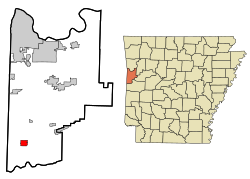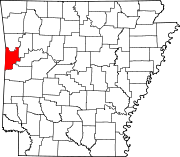Hartford, Arkansas: Difference between revisions
Red riot83 (talk | contribs) |
Red riot83 (talk | contribs) |
||
| Line 84: | Line 84: | ||
{{Mapit-US-cityscale|35.023358|-94.378398}} |
{{Mapit-US-cityscale|35.023358|-94.378398}} |
||
*[http://hartford.k12.ar.us The Hartford High School Website] |
*[http://hartford.k12.ar.us The Hartford High School Website] |
||
*[http://query.nytimes.com/mem/archive-free/pdf?res=9F03E2DB1F31E233A25757C0A9629C946396D6CF New York Times Article on Peter Stewart] |
|||
{{Sebastian County, Arkansas}} |
{{Sebastian County, Arkansas}} |
||
Revision as of 03:28, 8 October 2008
Hartford, Arkansas | |
|---|---|
 Location in Sebastian County and the state of Arkansas | |
| Country | United States |
| State | Arkansas |
| County | Sebastian |
| Area | |
| • Total | 1.8 sq mi (4.7 km2) |
| • Land | 1.8 sq mi (4.7 km2) |
| • Water | 0 sq mi (0 km2) |
| Elevation | 653 ft (199 m) |
| Population (2000) | |
| • Total | 772 |
| • Density | 428.9/sq mi (164.3/km2) |
| Time zone | UTC-6 (Central (CST)) |
| • Summer (DST) | UTC-5 (CDT) |
| ZIP code | 72938 |
| Area code | 479 |
| FIPS code | 05-30490 |
| GNIS feature ID | 0077137 |
Hartford is a city in Sebastian County, Arkansas, United States. It is part of the Fort Smith, Arkansas-Oklahoma Metropolitan Statistical Area. The population was 772 at the 2000 census.
Geography
Hartford is located at 35°1′24″N 94°22′42″W / 35.02333°N 94.37833°WInvalid arguments have been passed to the {{#coordinates:}} function (35.023358, -94.378398)Template:GR.
According to the United States Census Bureau, the city has a total area of 1.8 square miles (4.7 km²), all of it land.
Demographics
As of the censusTemplate:GR of 2000, there were 772 people, 299 households, and 217 families residing in the city. The population density was 427.3 people per square mile (164.7/km²). There were 346 housing units at an average density of 191.5/sq mi (73.8/km²). The racial makeup of the city was 93.52% White, 1.17% Native American, 0.13% Asian, 1.55% from other races, and 3.63% from two or more races. 2.46% of the population were Hispanic or Latino of any race.
There were 299 households out of which 30.1% had children under the age of 18 living with them, 56.2% were married couples living together, 11.4% had a female householder with no husband present, and 27.4% were non-families. 24.1% of all households were made up of individuals and 13.0% had someone living alone who was 65 years of age or older. The average household size was 2.58 and the average family size was 3.05.
In the city the population was spread out with 26.4% under the age of 18, 7.1% from 18 to 24, 27.3% from 25 to 44, 21.6% from 45 to 64, and 17.5% who were 65 years of age or older. The median age was 38 years. For every 100 females there were 93.5 males. For every 100 females age 18 and over, there were 90.0 males.
The median income for a household in the city was $22,500, and the median income for a family was $27,321. Males had a median income of $28,250 versus $22,813 for females. The per capita income for the city was $10,845. About 19.2% of families and 25.9% of the population were below the poverty line, including 39.0% of those under age 18 and 18.3% of those age 65 or over.
History
The town of Hartford was first called Gwynn when it was originally settled. Prior to 1900, the town saw the arrival of the Rock Island Railroad and the town's name was changed to Hartford. Hartford was incorporated in 1900 and as a result, the old original town of Hartford, about one and a half miles west and named for a creek crossing belonging to the Hart family, is now generally referred to as "Old Town" or "West Hartford". According to Goodspeed's "History of Arkansas", William J. Fleming and William Stevenson opened the first store in West Hartford. By 1891 there were several businesses, a public school, and a Union Church edifice used respectively by Methodists, Baptists, and Cumberland Presbyterians.
The town of Hartford was incorporated February 28, 1900.
In 1912, Hartford elected Peter Stewart as mayor. He was the first socialist mayor elected in Arkansas.
During the early half of the twentieth century, the town was home to the Hartford Music Company, which published Gospel music and operated a singing school. The city was also home to significant mining activity, which has returned to a limited extent. Most farm owners have oil or gas pumps in farmland across the town.
References

